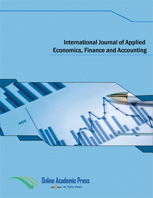Monetary Policy Effectiveness and Financial Inclusion in Nigeria: FinTech, ‘the Disrupter’ or ‘Enabler’
DOI:
https://doi.org/10.33094/8.2017.2021.91.19.27Keywords:
Financial inclusion, Financial technology, FinTech, Monetary policy, Nigeria.Abstract
The extent monetary policy is effective in achieving financial inclusion has been scarcely investigated in the literature. Hence, this study examined the extent monetary policy is effective in achieving financial inclusion in Nigeria and whether FinTech improves or impedes this relationship. Quarterly time series data spanning from 2009 to 2019 from the Central Bank of Nigeria were used for estimations. Johansen’s cointegration test and fully modified OLS were used to carry out the analysis. The result shows that measures of monetary policy effectiveness, such as inflation rate and lending rate all had a significant effect on financial inclusion in the country. It was also discovered that accounting for FinTech in the model improves the effectiveness of the monetary policy on financial inclusion in Nigeria, contrary to popular assertion that Fintech impedes monetary policy effectiveness. The study concludes by emphasizing the role of monetary policy in achieving financial inclusion in Nigeria.




